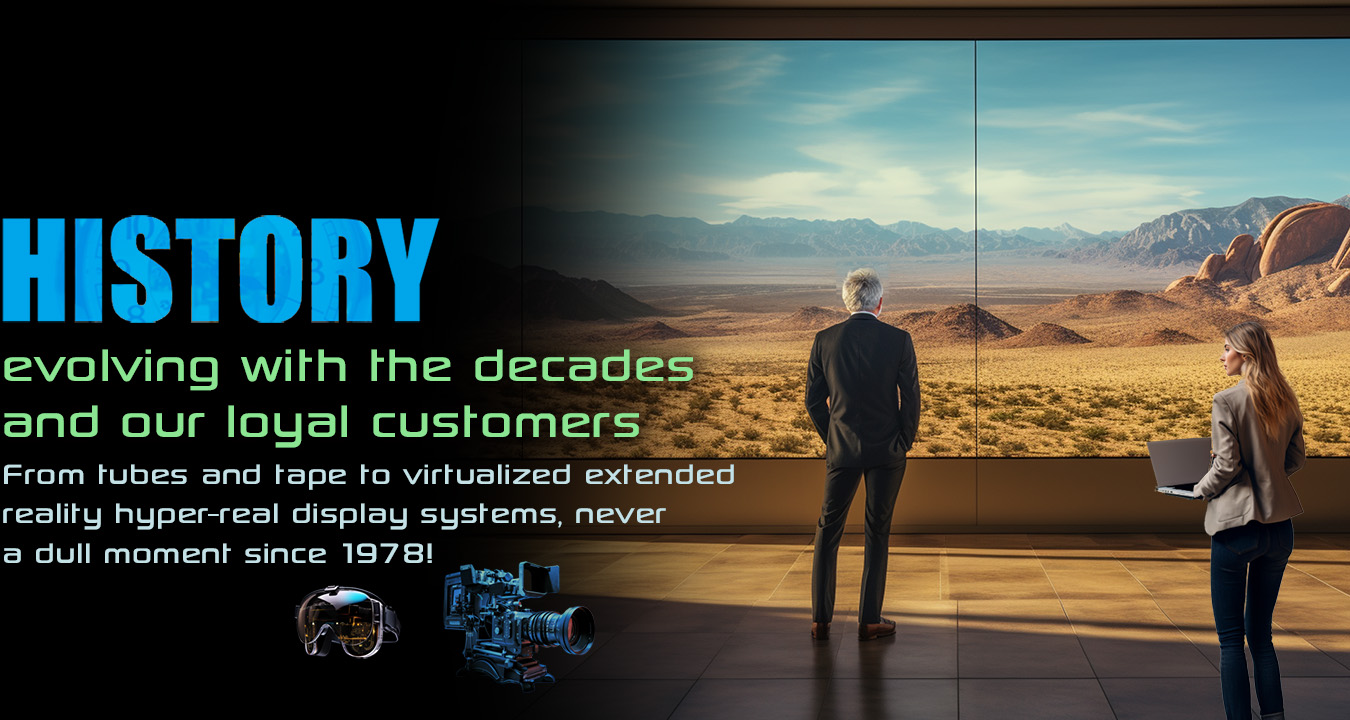A brief history of EAR
EAR, established in 1977 as EAR Sound Consultants, initially provided high-quality audio equipment to Phoenix musicians. In the 1980s, the company rebranded to EAR Professional Audio Video, evolving into a reseller and national integrator of products and services for professional audio and video. EAR is now one of the longest-lived and most progressive broadcast technology companies in North America.
ABOUT THIS HISTORY PAGE:
This history highlights the hundreds of people who have built EAR and kept the company running smoothly for the past 50 years. To them, we say “Many thanks!” For those curious about how a decades-old professional technology company can thrive amidst constant industry changes, this document may be informative and entertaining. EAR’s story is one of passion for technology and innovation, riding the waves of change from early advancements to today’s AI and cloud-based resources. This history focuses on major technological shifts and how EAR has thrived through each one.
THE 1980’s
In the early 1980s, audio and video equipment evolved rapidly. During this time, EAR provided professional audio products for music recording, public address, broadcast, and industrial applications. Notable clients included Paul McCartney, ABC, Playboy Club International, Robert Altman, Earl Scruggs, Seal, K.D. Lang the Steve Miller Band and (with great appreciation) many others. Despite the Economic Recession of the early 1980s, EAR survived without outside investment or outside financial resources, demonstrating resilience even as a young company.

Circa: 1981, The 8 track 1/2″ tape machine that launched a new era in personal recording and the start of EAR Professional Audio Video.
In the fall of 1983, EAR moved to their current location at 27th Street and East McDowell Road in Phoenix, establishing themselves as a unique professional audio company in the Southwest. Music stores and video resellers often referred clients to EAR to solve audio workflow challenges, including synchronizing video and audio tape transports. In 1982, EAR built one of the first cost-effective 1/2 inch 8-track to film synchronization systems for film legend Robert Altman using a BTX Shadow controller and the Tascam 80-8, a leap forward from film-based systems offered by Moviola and others. The technical challenges in managing the synchronizing of audio and video tape transports required engineering expertise, intense factory training and constant adjustments. EAR provided many major post-production houses throughout the Southwest with this technology and leveraged this expertise with video editing systems in the years to come.
Prior to the mid-1980s, building a recording studio required substantial investment, expert engineers, and large spaces due to limited multi-tracking and noise issues. The transition from 2-inch tape transports to compact digital recorders revolutionized the industry. EAR capitalized on new products from Yamaha, JBL, Tascam, and Otari, significantly improving quality with digital-based technology and greater cost-effectiveness. This shift drastically reduced startup costs for recording studios and marked the end of the era of large analog audio recording equipment.

Above: In the days before ecommerce (or the internet for that matter) EAR sold hundreds of audio processors every year. They would arrive by the pallet and sell quickly. Today we’re back to selling products by the pallet through ecommerce and no longer need to keep multiple showrooms running to accommodate client’s needs.
By 1989, EAR started delivering computer based editing products by Dyaxis and Digidesign. Some were working with Apple Computers(tm) and some controlling large audio consoles, quite a marvel for their day – but simple by today’s standards. It was still very exciting to think that you could move between edits with almost instantaneous commands. This space age user interface boasted a crazy new feature called an “undo” button. Once again, simple by today’s standards, but revolutionary at the time; a perfect prelude for things to come.
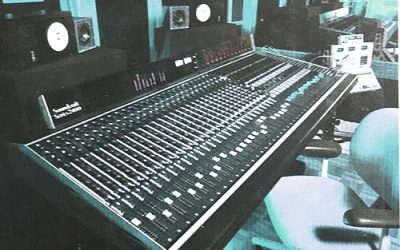
EAR’s main showroom circa 1991. Featuring Otari 2″ 24 tracking with Soundcraft console.
EAR was also tracking the emerging changes in the video editing world, with more compact tape formats and affordable editing systems from JVC, Panasonic, Sony, Grass Valley and Ampex. As audio technology downsized and video editing evolved, EAR strategically focused on video’s first widely available nonlinear editing products. EAR invested heavily in ramping up both their audio and video nonlinear technology. By the end of the 1980s, EAR fully encompassed video into their offerings, changing their name to EAR Professional Audio/Video in August 1987. Around this time, the startup Avid Media Composer gained attention with its nonlinear video-editing product. EAR became the Southwest’s first Avid reseller and remains Avid’s oldest reseller to this day.
THE 1990’s
Historically EAR has been successful in not just delivering systems, but also delivering solutions. During the 1990’s EAR evolved into a company that sold both traditional products and newer computer based systems.
Typical of dramatic changes in high technology products, some people adopted early. While the subjective quality of the new hard disk based editors left some hold outs, many were quick to save money and benefit from the much quicker, new “non-linear” editing workstations. It would be a few more years before hard disk based editing was “broadcast quality”.
Just when the nonlinear world was taking its first step, the tape world signaled it was not going to give up without a fight. In 1991 a fledging start up company, Alesis Corporation, introduced another juggernaut to the production world – A digital audio tape machine based on a VHS video cassette transport. Unlike its predecessors, the “ADAT” had 8 audio tracks and a price that left the remaining analog tape manufactures dazed and stunned. EAR again thrived nationally providing complete packages of ADAT based digital recording systems including audio mixing consoles, processing and cabling.
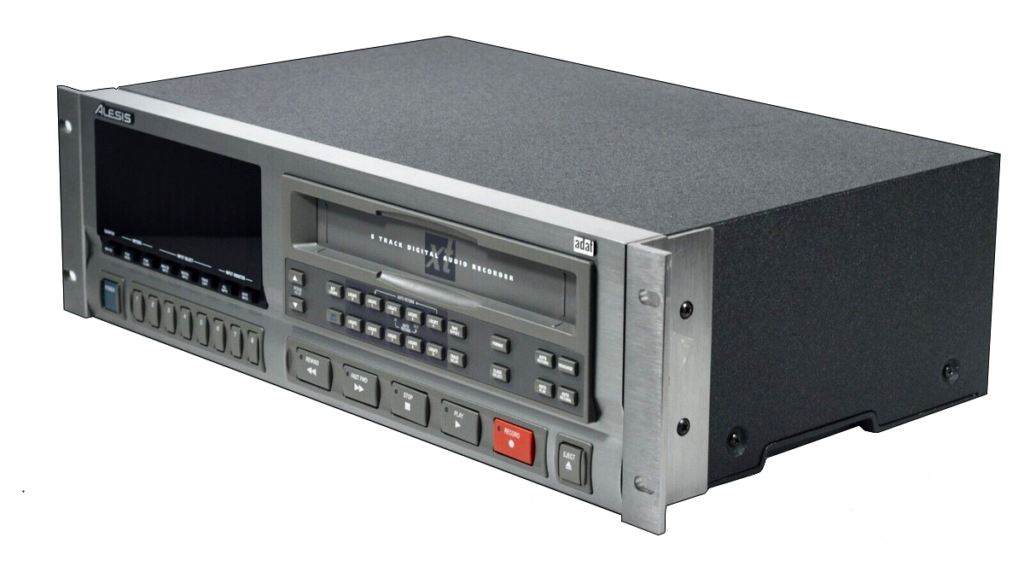
Circa 1991, Alesis introduced the ADAT, a digital tape format using a hybrid cassette based on the VHS format. Paired with a Mackie console, this innovation created a sub-$10,000 entry point for a complete home studio. EAR sold hundreds of these systems in the 1990s.
In 1989 EAR became the first Apple, Avid and Digidesign professional audio reseller in the Southwest featuring the new Digidesign “Pro Tools” (later purchased by Avid Technologies). At only $6,000 it was a bargain! Professional Ampex, MCI or Otari tape decks were $4,000-$25,000 alone. The new price point and 16bit resolution made it an instant hit with smaller production companies and studios. The workflow of the day still required your edited project to be finished back to tape (ie: “layback”). However, the cost savings of buying one tape deck compared to multiple decks more than paid for the cost of the computer and software.
In 1993 Avid, the already successful manufacturer of $100,000 editing systems announced the first “affordable” editing solution Media Suite Pro. EAR, the first Avid reseller in the Southwest, flourished and the new “MSP” was a huge success. At only $30,000 it was a bargain! Professional Sony tape decks were $15,000-$25,000 alone. The new price point and “AVR25″ resolution made it an instant hit with smaller production companies and schools.

Circa 1995, Main showroom featuring the emerging workstation market for non-linear audio and video editing. Avid “Media Suite Pro”, Digidesign “Pro Tools” were quickly replacing tape based editing.
The Mid 1990’s were filled with gains and also losses. The industry was quickly changing and the future seemed very puzzling. It would be unrealistic to tell this story with including a few dips and disillusions along the way. The market was forcing a shift in the industry landscape. With the success of the ADAT and the emergence of mass produced products, everything was getting inexpensive, very quickly. Artists recording records that had demanded hundreds of thousands of dollars worth of production gear with an engineer just a few years prior, were now sing inexpensive portable gear at home. It didn’t take long to figure that if the trend of “get more for a lot less” continued, everyone would own a personal home recording studio for $300 and the expertise and years of investment by EAR and its professional customers would be soon ready for the glue factory. The professional audio recording market had begun migrating into personal “projects studios” and outside of the major recording markets everyone was going to have to evolve or get out of the business. And evolve EAR did.

1990 remodel of East McDowell offices. After 40 years in our 3rd location, we’re moving to a new location in 2025!
EAR Product & Services
THE 2000’s
By the 2000s, EAR transitioned to non-linear, disk-based editing systems, moving away from traditional tape. Branding themselves as the “Workstation Company,” EAR navigated significant industry changes and continued to thrive by embracing new technologies and trends.
Just as quickly as revolutionary products like the Alesis ADAT took hold of the professional audio industry, in a flash, they were gone. By 2001, Alesis’s business suffered as market trends changed, and on April 27 of that year, Alesis could not remain profitable and closed it’s doors. It would soon become common for the disruptors of the industry to have their day (however brief) an be quickly replaced by “the next big thing”. These trends spanned more than just products as streaming and computer based software products began to emerge. Yesterday’s vintage tube processors were becoming today’s software plug-in.
The mechanical tape based products of the 1980’s and 1990’s were fading fast as computer based recording and editing systems were able to record with increasing fidelity and functionality. To put it simply, these new hard disk based products made editing simpler and faster with much greater flexibility and many more features. The buzz was all about “Non-linear editing”, hardly a term we use today now that the age of tape has passed.
Our industry was now firmly based in the computer age. EAR’s service department, for many decades busy with cleaning, lubricating and adjusting 400 pound tape machines became a digital hub for computer based system configurations. With manufacturers like Avid, DigiDesign, many editors looking to start their own businesses. They quickly learned 100,000 of dollars of tape based audio and video equipment could be replaced with a computer based workstation system at a fraction of the cost. The days of the “big production studio” were coming to an end as smaller edit facilities could compete with cost effective hard disk based editing systems.
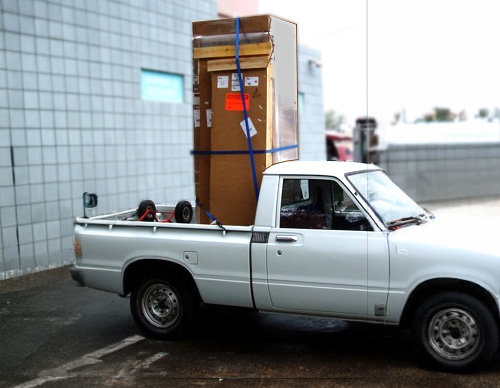
Circa 1997: Terabyte System sold to animation gaming company for $225,000. Weighing in at 450lbs (205Kg) in a 7 foot computer rack, the system was connected via “blazing” 100 Mbps (mega-bits) network switch.
In the 2000s, major advancements in production technology included affordable high-definition and non-linear editorial equipment for audio and video. EAR branded itself as “The Workstation Company” and became the primary provider of audio and video editing systems in the Southwest USA. Synchronizing legacy mechanical tape systems was challenging, but EAR’s expertise ensured optimal performance. Projects with artists like Paul McCartney, Lyle Lovett, Bonnie Raitt, and Justin Timberlake validated EAR’s skills during a booming era of post-production editing.
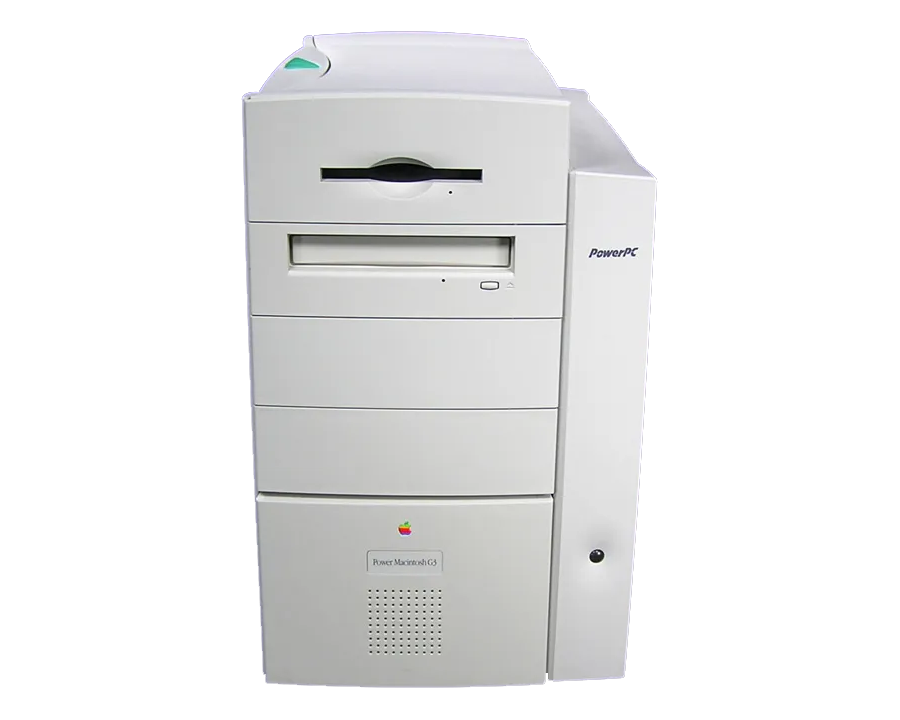
Circa 1995: Apple G3 beige computer. The work horse audio and video editing workstation due to it’s ability to support internal 3rd party hardware cards. Paired with an Avid 2GB external hard drive ($2,000 each) they were a formidable editing platform. EAR sold 100’s of these through the 1990’s and into the early 2000’s.
In 2000, Apple dominated the market with their G4 models, becoming the standard for editing hardware companies like Avid and Media 100. They were in many senses, the only mature professional computer hardware platform for the previous decade. For many manufacturers, this reliance on Apple created pressure to develop competing Windows products. Steve Jobs leveraged the movie industry and reacted by developing Apple’s own software products for editorial, special effects, and CD authoring.
Apple’s new flagship product, Final Cut Pro, became the first affordable and functional professional video editing software on the Mac platform and was quickly adopted by many. At the 2000 National Association of Broadcasters convention (NAB) in Las Vegas, Apple promoted Final Cut Pro by giving away T-shirts mocking the industry’s high-priced competitors with the slogan “Video Editing Systems, 99% off.” At that time, Avid Technologies was one of Apple’s largest customers. Avid reacted by announcing they would leave the Mac platform in the near future, leading to a heated multi-year battle that caught EAR and many professionals in the crossfire.
With computer processing power evolving beyond the limitations of specialized hardware, Apple swept the market with products offering similar functionality to $100,000 editing systems at a fraction of the cost. This marked the end of an era where the cost of setting up a broadcast editing suite plummeted from $250,000-$1,000,000 to under $50,000. Tape decks and specialty graphics and editing hardware were replaced by smaller, faster, and more affordable non-linear editing software on standard Mac and PC computers. EAR, branded as the “Workstation Company” in the late 1990s, faced significant challenges as these changes jeopardized their livelihood and those of their clients. The financial barrier to setting up a post-production editorial suite plummeted, leading to an 80% drop in the hourly rate for services. While making editing hardware and software highly affordable was seen as a positive trend for non-professionals, it forced many professional editing facilities worldwide to adapt or close up shop. It was time for EAR to evolve again from “The Workstation Company” and embrace the next technology shift.
For over 100 years film and tape were the professional formats for acquiring and finishing professional audio and video content. The combination of faster computer processors, affordable fast disk drives and the related speed and cost advantages – the transition to non-liner disk based system continued to evolve with increasing demand. The transition from tape-based to hard disk-based recording revolutionized the editorial process, shifting from linear to random access and greatly enhancing speed and accuracy. Combined with the evolving shift from standard definition formats to high-definition audio and video, a surge in demand created a wave EAR rode for over 10 years.


